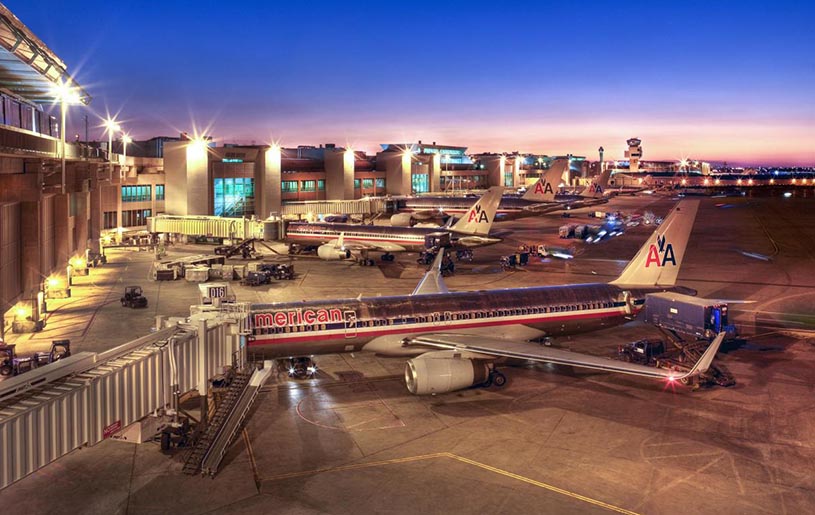
Miami, as the most exotic gateway city on the southeast coast of the United States, is not only a microcosm of the fusion of Latin American culture and the United States, but also one of the destinations that global travelers yearn for with its long coastline, vibrant nightlife and shopping paradise. Whether you are departing from Asia, Europe, or other cities in North America, how to reach this tropical city with the best cost-effectiveness is a part of your travel plan that you have to consider.
1. Overview of Miami International Airport (MIA)
Miami International Airport is one of the busiest aviation hubs in the southeastern United States, located about 13 kilometers northwest of downtown Miami. The airport has more than 80 international routes covering cities in the Americas, Europe and the Middle East, and is an important hub for American Airlines.
Due to its superior geographical location, MIA is particularly suitable for transfer passengers from Latin America, the Caribbean, and the northeastern and southwestern United States. It has also become a transit point for many long-distance passengers to Central and South America.
2. Direct flights: efficient and convenient preferred options
Direct flights are the preferred method for many travelers, especially for tourists who are short on time or prefer a comfortable experience. American Airlines offers a large number of direct flights from New York, Dallas, Los Angeles, London, Madrid and other places to Miami, with wide coverage and high frequency. Most of the flight models are Boeing 777 or Airbus A321, and the service is stable and reliable.

Delta Airlines departs from hub cities such as Atlanta, New York, and Detroit to ensure route density and connection efficiency, and frequent travelers can make full use of its mileage system to redeem flight segments.
If you depart from Europe, British Airways’ direct flights to London are very popular. Air France and KLM also open seasonal direct flights at specific times, especially for passengers from France, Belgium, the Netherlands and other countries.
This direct flight is particularly suitable for business travelers, parent-child families and elderly passengers with limited time, reducing the pressure of transit. At the same time, if you plan to go deep into other parts of Florida, going directly to Miami will save a lot of energy for the journey.
Direct flight fares fluctuate depending on the departure point. Generally, the one-way fare for economy class is between US$300 and US$800, and the business class may be as high as US$1,200 to US$2,500. It is recommended to book 1 to 2 months in advance to get a better price.
3. Transfer flights: a more flexible and cost-effective option
Compared to direct flights, transfer flights provide a more flexible option for passengers with limited budgets or who like to “travel multiple cities”. European transfers such as Frankfurt, Amsterdam, Madrid and other cities are important hubs for airlines such as Lufthansa, Iberia, and KLM. In the Americas, New York, Dallas, Chicago, and Atlanta also have frequent connecting flights to Miami.
A highlight of the transfer route is the “multi-city connecting ticket” function. For example, Middle Eastern airlines such as Qatar Airways and Etihad Airways allow passengers to stay in the transfer city for 1 to 2 days, which is an extra trip in disguise.
Copa Airlines in Central America provides transfer flights from many places in Latin America to Miami via Panama City, which is popular for its fast connection and high-quality service. JetBlue’s flights from New York and Boston are mainly selling points for affordability and comfortable seats.
Budget tourists, backpackers, long-term travelers, and price-sensitive travelers are more suitable for transit options, especially in the off-season when they can get a round-trip fare of only US$250 to US$600.
It should be noted that transit flights may require visas in some cities (such as the United States), and even if they are just transiting, they need to be arranged in advance. At the same time, if the transit time is too long, you can book an additional airport lounge or transit hotel to improve comfort.
4. In addition to flight selection: insurance, refund, change and additional services
When booking a flight to Miami, in addition to comparing routes and seat comfort, travel insurance should not be ignored. Especially for passengers who choose connecting flights, they should give priority to insurance plans that cover “transfer delays”, “baggage delays” or “missed segments” compensation clauses, which can escort long-distance flights.

Some airlines support free changes to flight time, and there are also preferential terms that support refunds for vouchers or name changes. Be sure to read the conditions carefully before booking, especially whether a specific cabin class is limited, to avoid unnecessary economic losses caused by temporary changes. For passengers whose plans may change, it is strongly recommended to give priority to rebookable fares.
5. Baggage check-in, boarding suggestions and time difference adjustment
For flights involving transfers, pay special attention to whether the luggage needs to be re-checked in the middle. Transfers within the United States generally require passengers to pick up their luggage and check it in again. It is recommended to reserve sufficient transfer time.
There will be a 6 to 12 hour time difference when flying from Europe or Asia to Miami. It is recommended that passengers try to adjust their schedule on the first night after arrival. The impact of jet lag can be alleviated by adapting to sleep rhythm in advance and using melatonin.
In addition, you may wish to download travel tools such as airline apps, flight radars, TripIt, etc., to keep abreast of boarding gate changes, delay notifications, and standby upgrade opportunities to enhance your travel experience.
6. How to choose the best route according to your own situation?
Each passenger has different needs, so choosing the best route should also vary from person to person. For passengers who travel frequently or have extremely high requirements for time efficiency, direct flights are the first choice. United, Delta and American Airlines have multiple direct flights to Orlando, with wide route coverage and stable service. Through platforms such as Google Flights, you can not only quickly compare prices, but also check whether mileage points can be redeemed, which is especially suitable for frequent travelers.
For passengers with limited budgets or who want to visit other cities along the way, you can consider connecting flights. JetBlue, Copa Airlines, KLM Royal Dutch Airlines, etc. often provide more attractive transfer options, which are especially suitable for travelers who have flexible itineraries. Using platforms such as Expedia or Momondo, you can accurately filter transfer cities, duration and whether to transfer overnight, which is more conducive to planning the rhythm of travel.
If departing from Europe, Lufthansa, Air France, etc. provide multiple stable transfer points such as Frankfurt or Paris, which can easily connect to the Orlando route. It is recommended to lock in a round-trip combination ticket in advance, which generally enjoys a more favorable overall price.
It is recommended that families with children or older travelers avoid transfers, and direct flights can reduce the fatigue of traveling. Young travelers who love to explore and have flexible time can use transfers to visit other cities and enjoy the fun of multiple trips.

7. Things to note for flights to Miami
Check the boarding gate and airport terminal information in advance
Miami International Airport (MIA) is a large hub with complex terminal divisions. International and domestic flights are often distributed between different terminals, especially American Airlines (AA) almost exclusively occupies a terminal in Terminal D. Airlines such as United and Delta need to go to other areas. It is recommended to confirm the boarding gate and terminal location one day before departure to avoid temporary route finding and delay in boarding.
The frequency of flights affected by weather in the south is higher
Miami has a tropical monsoon climate, and thunderstorms and short showers are common in summer, which can easily cause flight delays or temporary cancellations. Especially from noon to afternoon, boarding or runway operations may be suspended due to lightning warnings. It is recommended to choose flights departing in the morning or early morning, and reserve a reasonable transfer buffer time.
Carry air-conditioning accessories or light jackets
Although the temperature in Miami is high throughout the year, the air conditioning in the airport and on the flight is generally turned on strongly, especially during long-distance flights or waiting periods, which can easily cause discomfort due to temperature differences. It is recommended to carry a light cape or jacket with you, and prepare a moisturizing spray or lip balm to cope with the dry cabin environment. If you have a cold constitution, it is recommended to choose a window seat to stay away from the air conditioning outlet.
Whether you yearn for Miami’s sunny beaches, carnival festivals, or use it as a transfer station to the Caribbean, choosing a suitable route is the first step to start a wonderful vacation. Direct flights mean saving time, while transfers bring more possibilities for exploration and saving.
According to your own budget, travel rhythm and purpose, arrange your itinerary reasonably. Your trip to Miami will start with a ticket, go further, and have more fun.


